In this article, we will review the Minelab GPX 5000 metal detectors, exploring their advanced technology, target applications, and key differences between models. The Minelab GPX 5000 series metal detectors stand out for their cutting-edge technology and versatility, catering to a wide range of metal detecting enthusiasts. Whether you are searching for gold nuggets in the wilderness or coins in urban settings, the GPX 5000 can be a valuable tool in your treasure-hunting endeavors.
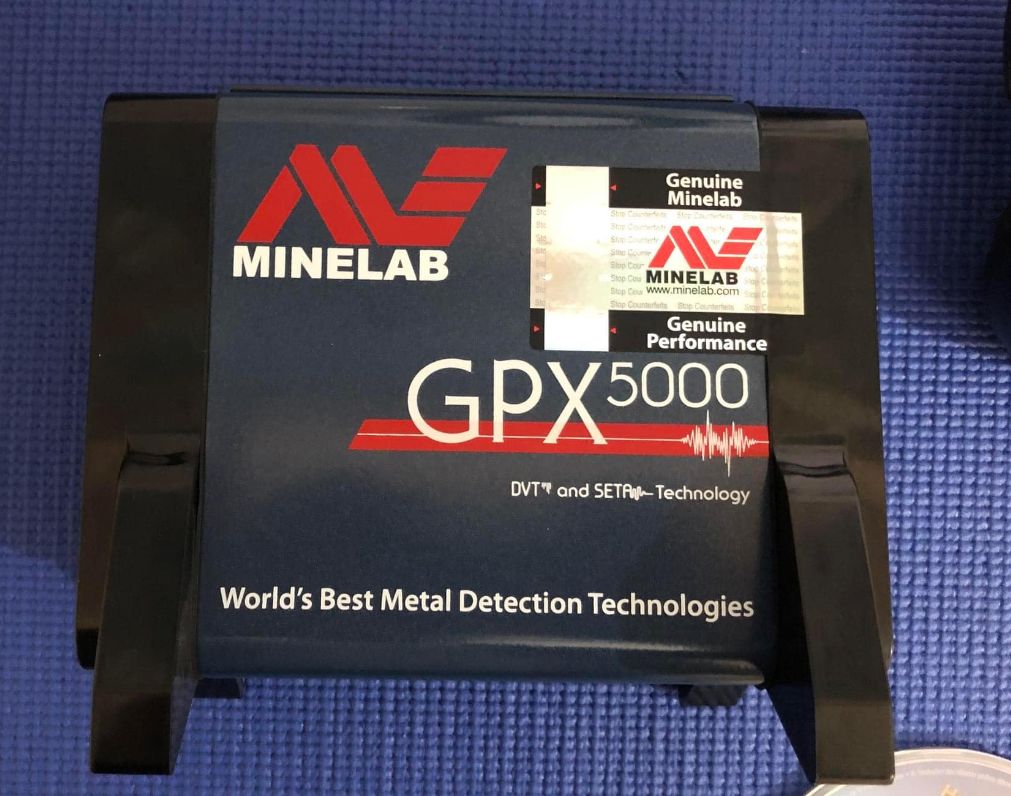
Contents
What the device was designed for?
Minelab’s GPX product line includes premium metal detectors specifically designed for gold nugget prospecting. Currently, three models are available for sale: the GPX 6000, GPX 5000, and the now-discontinued GPX 4000. The “GP” in the model name stands for Ground Penetration, while the index number indicates an increase in features and, consequently, price.
The entry-level model, the GPX 4500, offers three search modes, making it suitable for those new to the hobby. In contrast, the flagship model, the GPX 5000, boasts six search modes, providing users with greater versatility and adaptability in various environments. Additionally, it’s worth noting the GPZ 7000 metal detector, which belongs to a different product line. Although it is twice as expensive, it incorporates the latest technologies for advanced detection capabilities.
In this review, we will focus on the GPX 5000, as it stands out for its multifunctionality and comprehensive set of features. At the end of the review, we will provide a separate description for each of the models in the GPX series to help you make an informed decision.
| Model | GPX 5000 |
| Application | Gold Prospecting & Deep Relic |
| Technology | MPS, DVT & SETA |
| Frequency/Transmission | Bi-Level, Advanced Pulse Induction |
| Coil (standard) | 11″ Round Double-D plus 15 x 12-inch Monoloop |
| Audio Output | 6.35mm (1/4″) headphone or speaker jack |
| Headphones Supplied | Koss 100 ohm headphones |
| Visual Display | 64 x 128 pixels, transflective with white backlight |
| Backlight | Yes with adjustable automatic ‘time-out’ |
| USB Connectivity | No |
| Memory | Setting changes saved automatically and remain until changed or reset. Factory Presets can be restored on start-up |
| Depth Indication | No |
| Detect Modes | General, Deep, Hi-Mineral, Patch, Hi-Trash & Pinpoint (all user programmable) |
| Discrimination | Iron Reject: range 1 to 10 & All Metal |
| Timings | Normal, Sensitive Extra, Enhance, Sharp, Sensitive Smooth, Coin/Relic, Salt/Gold & Fine Gold |
| Audio tone | Variable Control 1 to 100 |
| Audio Type | Quiet, Normal, Deep & Boost |
| Ground Balance | Automatic Ground Balance, Fixed & Tracking: Slow, Medium & Fast. Quick-Trak button |
| Ground Balance Type | General, Specific & Ground Balance Off |
| Trash Density | No |
| Pinpoint | No |
| Sensitivity Adjust | Rx Gain 1 to 15 |
| Tune / Noise Cancel | Automatic & Manual 0 to 255 |
| Threshold | Adjustable turn control |
| Target Volume Adjust | Volume Limit 1 to 20 |
| Battery | Lithium-Ion with built-in amplifier (up to 12 hrs). Supplied with mains and vehicle charger |
| Low battery alert | Audio alert |
| Length | 1100mm – 1300mm (43.3″ – 51.2″) |
| Weight | 2.4kg (5.3lbs) including 11” coil (excluding battery and accessories). Battery weight 780g (1.7lbs) |
| Warranty | 3 years control box & coil |
- ADVANCED TECHNOLOGY. Powered by GeoSense-PI technology that precisely analyzes…
- FINDS ALL GOLD. This gold finder can accurately locate small fragments to large…
- BUILT TO LAST. Tested in the harsh environments of the Australian outback,…
- EASY TO USE. With automatic features and an easy interface, you’ll be an expert…
- LIGHTWEIGHT DESIGN. Made with lightweight carbon fiber shafts, this gold…
- POWERED ON. Keep your GPX 5000 Metal Detector powered up and ready to go with…
- PEACE OF MIND. Keep this spare battery cable on hand during adventures to…
- ADVENTURE ESSENTIAL. A must-have accessory for your metal detector, allowing you…
- FOR GPX 5000. This battery cable is specifically designed for use with the…
- RELIABLE CONNECTION. The 5-pin layout of this battery cable ensures a secure and…
Last update on 2025-07-10 / Affiliate links / Images from Amazon Product Advertising API / Source: Amazon Affiliates
The review
The GPX 5000 metal detector is a high-performance device designed for gold nugget prospecting, making it an essential tool for both enthusiasts and serious prospectors. It is available in two package sets: the standard set and the PRO set. The PRO package set offers several enhancements, including:
- Minelab Commander Series 15″ x 12″ Elliptical Monoloop
- Minelab Armrest Strap
- Minelab Finds and Rubbish Bag
- Minelab PROSONIC Wireless Metal Detector Audio System
- Armrest Strap, Armrest Wear Kit, and Coil Wear Kit
The metal detector is supplied in a standard cardboard box. While it may not contain extra items, the package includes various essential accessories.
Assembling the GPX 5000 metal detector is a straightforward task. Follow these steps to ensure proper assembly:
- Attach the search coil to the bottom shaft section.
- Assemble the shaft.
- Secure the plunger pin and handle onto the upper shaft section.
- Attach the armrest to the upper shaft section.
- Fasten the straps to the armrest.
- Place the control unit on a flat surface and connect the shaft to it.
- Wind the handle cable around the shaft, then fix it into the corresponding cable entrance of the control unit.
- Wrap the search coil cable around the shaft and secure it with touch fasteners. Insert the jack plug into the cable entrance of the control unit and tighten the fixation nut.
- Insert the battery accumulator into its compartment, ensuring the cable entrances are on the right side.
- Connect the battery to the control unit with the provided cable.
- Attach the elastic thread with a spring hook to the upper shaft pin, adjusting its length so that the thread supports the shaft without lifting it.
Your GPX 5000 metal detector is now ready for use!
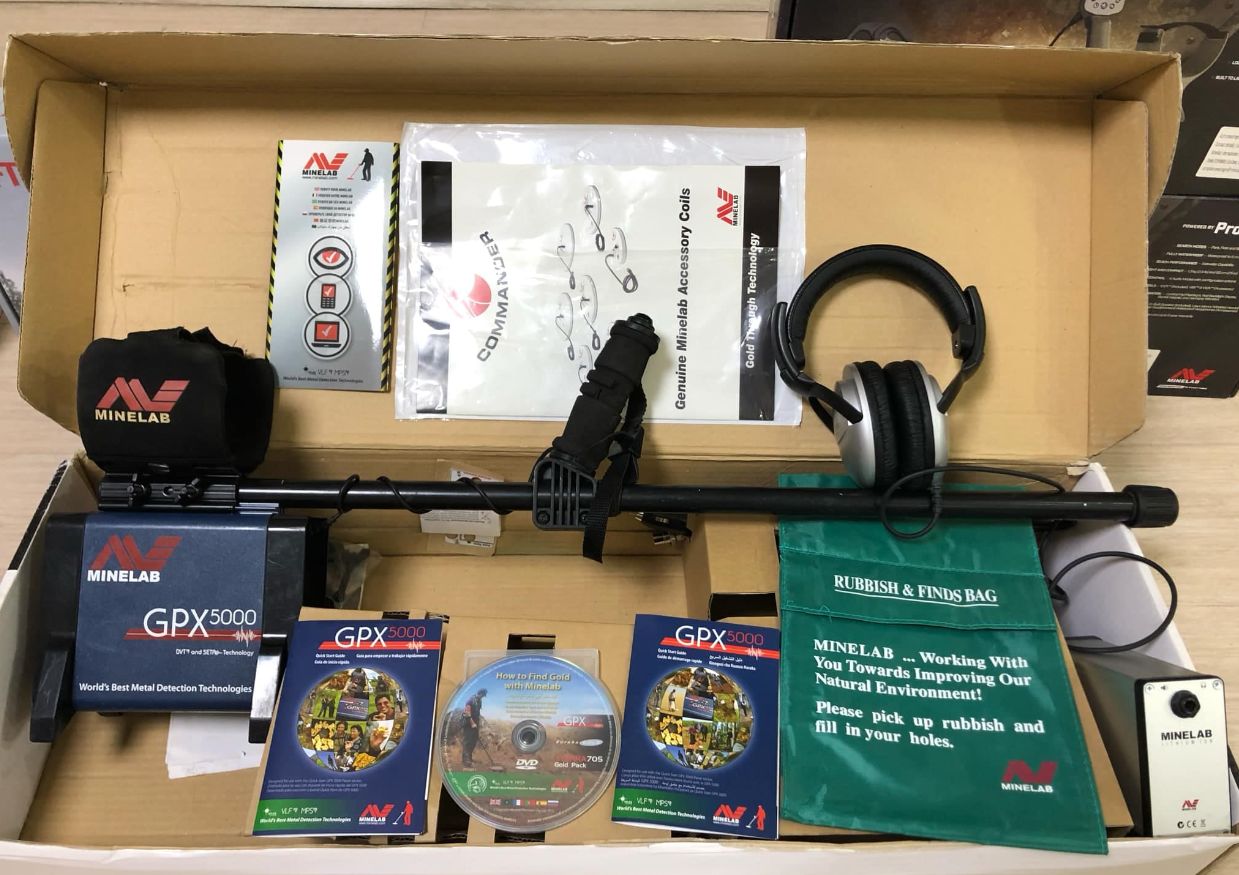
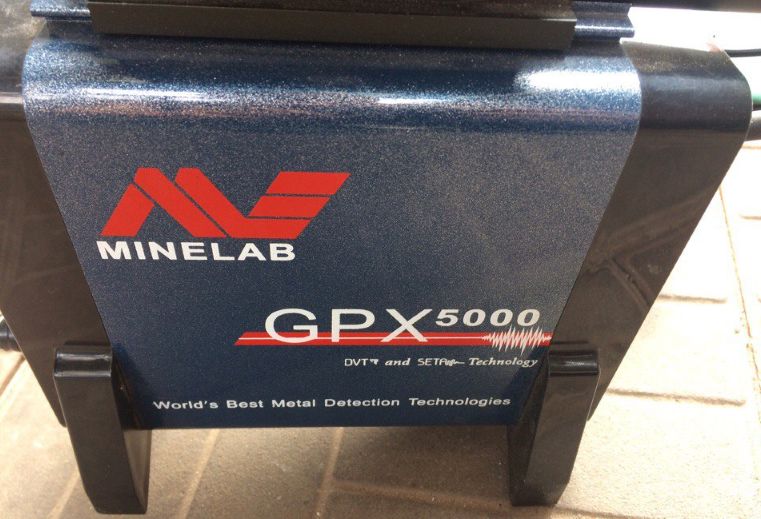
The shaft
All metal detectors in the Minelab GPX product line share the same design, with an adjustable length ranging from 1100 mm to 1300 mm (43.3″ to 51.2″).
The device consists of two main units: the control unit and the battery unit. The control unit is mounted under the armrest and features control panels on both the front and back. The battery unit, which the user carries, contributes to a total weight of 2.4 kg (5.3 lbs), excluding the battery.
One key consideration for using the GPX 5000 is the method of carrying it. The most convenient way to transport the metal detector is by using a utility vest. Carrying the device by hand can be uncomfortable due to its weight, especially with the battery attached to your belt. Using a 15-inch search coil can increase fatigue quickly, making a utility vest essential for comfort and efficiency. I recommend opting for package sets that include a utility vest to maximize your experience with the device.
The GPX 5000 features a straight shaft that supports the entire construction, enhancing stability and balance, which contributes to improved detecting performance. The control unit and the bottom shaft section, which houses the search coil, are both attached to this shaft. Additionally, the handle can be adjusted to accommodate the user’s arm length, allowing for a more customized fit and greater comfort during use. This ergonomic feature not only helps reduce strain during extended detecting sessions but also improves overall handling.
Many users find that using a utility vest not only helps in carrying the weight of the detector but also provides easy access to additional gear or tools, making the prospecting experience more enjoyable and efficient.
The coil
The GPX 5000 package set includes two search coils: an 11″ Double-D and an 11″ Monoloop. It’s important to note that this specific package set is unique to the GPX 5000, as other GPX models may come with different search coils.
Additionally, the GPX 5000 offers two package sets: the standard set and the Pro set. The Pro set includes an extra search coil, a 15″ x 12″ Monoloop, which enhances the versatility of the device.
The GPX 5000 operates using Pulse Induction (PI) technology, distinguishing it from VLF (Very Low Frequency) metal detectors. As a PI device, it is particularly effective for searching deep targets, such as gold nuggets. However, this technology comes with certain limitations; while it excels at detecting deep targets, it struggles with recognizing targets based on their conductivity and inductivity.
As a result, discrimination capabilities in PI devices are minimal, which confines their applications primarily to gold prospecting. Other potential uses, such as coin shooting, jewelry hunting, and relic recovery, follow but are secondary.
While the GPX 4500 is predominantly focused on gold prospecting, the GPX 5000’s broader range of search modes allows it to be used for a variety of target types, making it a more versatile option for users interested in different detecting applications.
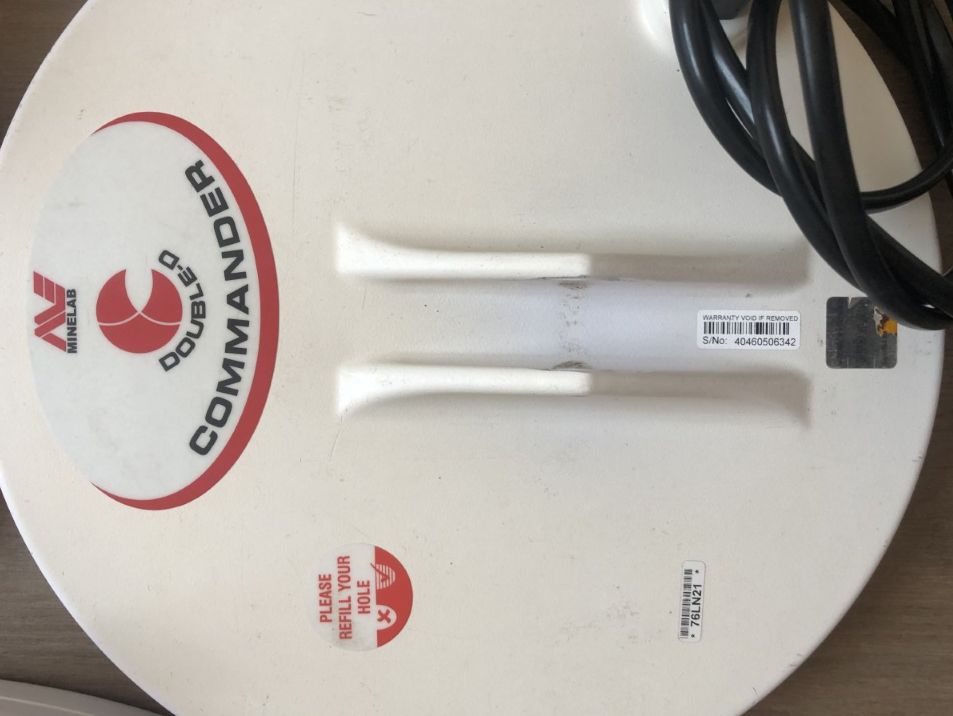
Headphones
All metal detectors in the Minelab GPX product line come equipped with headphones, enhancing the user experience during detecting sessions. The less expensive models feature wired headphones with a 6.35 mm (1/4″) jack, while the higher-end models offer a wireless headset, providing greater freedom of movement.
The headphone jack is conveniently located on the battery holder. This design is particularly beneficial, as it allows users to easily place the metal detector on the ground without dealing with multiple wires. When using a utility vest, there will only be one loose wire connecting the metal detector to its control unit, minimizing tangling and enhancing comfort during use. This thoughtful placement contributes to a more streamlined and enjoyable detecting experience.
The battery
The metal detectors in this product line are equipped with a modern lithium accumulator battery (7.4V-9.2 A/h) that charges quickly and provides approximately 13 hours of continuous operation.
This battery is conveniently stored in the utility vest rather than within the device itself, enhancing portability. Weighing 780 grams (1.7 lbs), the battery’s design allows users to carry additional spare batteries if needed, ensuring extended use during treasure hunting sessions.
A significant advantage of this battery is its charging flexibility; it can be recharged even after just one hour of use. This means it does not need to be fully discharged before charging, providing convenience for users on long excursions. A complete charging cycle takes a minimum of three hours.
The device package includes a charging unit that allows you to recharge the battery from a standard electrical outlet or in your car while traveling to your digging site. This feature ensures that you can maintain power without interruption, enhancing your overall detecting experience.
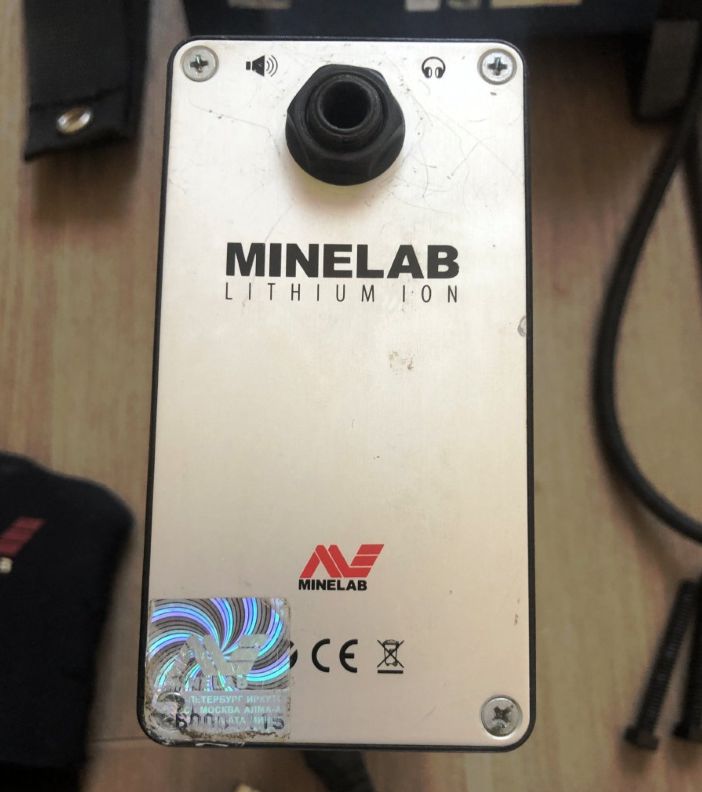

The control unit
The GPX 5000 operates using pulse induction (PI) technology, making it user-friendly despite its advanced features. It is equipped with a compact LCD display that features backlighting for visibility in various lighting conditions. The control panel consists of five multifunction switches and three potentiometer regulators, allowing users to fine-tune their settings easily. The user interface supports four languages: English, Spanish, Russian, and Arabic, catering to a global audience.
The detector offers multiple modes, including deep, custom, and user-defined settings, enabling users to tailor their experience to specific prospecting needs. Notably, the GPX 5000 includes Coin and Relic modes, which are commonly found in VLF metal detectors, enhancing its versatility for different treasure hunting scenarios.
A convenient button on the handle allows for seamless switching between the main ground balance mode and tracking mode. Releasing the button quickly returns the device to the main mode, providing efficient ground balancing when necessary. With a comprehensive settings menu, the GPX 5000 is equipped for professional-level prospecting, ensuring that users can maximize their detection capabilities.
Additionally, the device’s settings menu is extensive, allowing for precise adjustments to optimize performance for various environments and target types. Users can experiment with different configurations to find the best setup for their specific hunting conditions. This flexibility is particularly advantageous for experienced detectorists looking to refine their skills and enhance their treasure-hunting results.
Search modes
The Minelab GPX 5000 is a professional-grade metal detector designed for serious treasure hunters. Users must remain actively engaged throughout the hunting process, considering various factors beyond just device adjustments. The GPX 5000 offers a range of pre-set modes tailored to different searching needs, including:
- General
- Deep
- Custom
- Patch: for quick searches and initial area exploration
- Hi Mineral: designed for highly mineralized ground
- Hi Trash
Additionally, the device features multiple timing options, including:
- Enhance
- Normal
- Sensitive Smooth
- Sensitive Extra
- Sharp
- Salt Course
- Coin/Relic
- Salt/Gold & Fine Gold
It’s important to note that the search modes differ between the GPX 4500 and GPX 5000 models. Therefore, a thorough review of the user manual is recommended, as it spans approximately 100 pages and covers essential device peculiarities.
While the differences between the GPX 4500 and GPX 5000 are subtle, certain modes are exclusive to each model. For instance, the “Fine Gold” and “Salt/Gold” modes are unique to the GPX 5000, whereas the GPX 4500 includes the “Salt Course” mode. Notably, the GPX 5000 offers six pre-set search modes compared to the three found in the 4500 model.
The GPX 5000 incorporates advanced technologies such as Multi Period Sensing (MPS) and Dual Voltage Technology (DVT).
Multi Period Sensing (MPS) significantly enhances sensitivity, especially in the upper soil layers. This technology alternates between sending short and long pulses into the ground, which increases the maximum detection depth by up to four times compared to the GPX 4000.
Dual Voltage Technology (DVT), originally developed for military applications, improves sensitivity to smaller objects. It works by adjusting the voltage of the electromagnetic field emitted by the search coil, ensuring effective compensation for mineral inclusions in the ground.
Furthermore, the GPX 5000 utilizes Smart Electronic Timing Alignment (SETA), which reduces sensitivity to highly ferromagnetic soils. This technology enables the device to operate effectively on complex ground conditions while maintaining its original detection depth. Unlike many other detectors that automatically reduce detection depth in highly mineralized or saline environments, the GPX 5000 maintains high performance levels.
A new feature displays the tracking speed of the search coil, which is crucial for optimizing target response time and ground balance values. Selecting the appropriate tracking speed that corresponds to the user’s movement helps minimize interference and maximizes detection depth, enhancing the overall efficiency of the metal detecting process.
Ground balance
The Minelab GPX 5000 features an automatic ground balance function that enhances its usability in various soil conditions. When activated, this function operates in Tracking mode, continuously adjusting the ground balance based on the soil composition as the user moves. This ensures optimal detection performance regardless of changing ground conditions.
However, users have the option to turn off the automatic ground balance feature. In this case, the metal detector will perform a single ground balancing operation, after which it will not adapt to subsequent changes in ground parameters. This can be beneficial in certain scenarios.
In specific ground types, such as sand or non-mineralized black soil, there may be minimal interference from the ground. In these instances, turning off the ground balance function can actually enhance the device’s detection depth and sensitivity, allowing for improved target identification.
It is also important to note that the GPX 5000 offers extensive capabilities for adjusting ground balance, significantly increasing its sensitivity to small gold nuggets even in highly mineralized soils. This versatility makes the GPX 5000 a powerful tool for serious prospectors aiming to maximize their finds.
The Tracking mode uses advanced algorithms to detect minute changes in ground composition, ensuring consistent performance. Users can fine-tune ground balance settings to suit specific hunting environments, providing greater control over detection parameters. Many users report that turning off ground balance in specific soil conditions has led to the discovery of previously missed targets. Additionally, the device allows for sensitivity adjustments to further enhance performance based on terrain and target size. The automatic ground balance feature is particularly useful in varying terrain, such as rivers and sandy beaches, where soil conditions can frequently change.
Discrimination
The Minelab GPX 5000 features an effective discrimination function, which is especially notable for users employing Double-D (DD) coils. This sound discrimination allows the metal detector to provide clear audio feedback; when the coil passes over a ferrous target, the threshold tone entirely disappears. This functionality can be finely adjusted, enabling users to avoid unwanted iron objects while hunting for coins, ensuring that valuable gold nuggets remain detectable.
Despite its strong performance, the discrimination function has its limitations. In areas with heavy trash, the device tends to pick up nearly every metal grain, which can be frustrating for users. This sensitivity to various metals means that while it excels in identifying desirable targets, it can also lead to an overwhelming number of signals from less valuable items. For treasure hunters in trashy environments, striking a balance between maximizing the chances of finding gold nuggets and minimizing the distractions from iron and other metals is essential. Users may need to experiment with settings and coil options to optimize their experience in these challenging conditions.
Noise cancel
Before heading out to dig, it’s crucial to eliminate various sources of noise, including electrical interference, radiation from mobile phones, and signals from electric power transmission lines. While these disturbances may seem minor, they can significantly impact the performance of Pulse Induction (PI) metal detectors like the Minelab GPX 5000.
To ensure optimal functionality, take a moment to identify and minimize these interferences in your surroundings. Doing so will help improve the detector’s sensitivity and accuracy, allowing you to focus on finding valuable treasures without the distraction of unwanted signals. By being mindful of your environment and taking steps to reduce interference, you can enhance your overall treasure-hunting experience.
Conclusions
The GPX product line, represented by the GPX 6000 and GPX 5000 models, has consistently demonstrated impressive results, making them widely favored by professionals around the globe. These metal detectors feature a comprehensive menu structure with numerous settings, ensuring high sensitivity to metal objects and considerable detection depth.
The GPX 5000 stands out from its predecessors with enhanced ground balancing capabilities, allowing for increased sensitivity to small gold nuggets in highly mineralized soil. Designed specifically for professionals seeking the utmost performance, this detector incorporates several innovations compared to the earlier GPX 4500 model. Among these innovations are new search modes, with the GPX 5000 initially offering six user-selectable search modes, alongside an additional customizable user mode out of four available options.
However, it’s essential to note that these devices are primarily gold prospecting metal detectors. While the manufacturer has included additional search modes tailored for coins and relics, successfully locating areas free from trash while coin shooting can be challenging. Using such an expensive detector for this purpose may seem less cost-effective.
Additionally, potential users should consider the device’s weight; the GPX series is designed for strong and enduring diggers. If you’re interested in gold prospecting but prefer a simpler setup, you might explore the Minelab Gold Monster 1000. This model offers straightforward settings, a lighter weight, and a more budget-friendly option while still delivering excellent performance for gold detection.

